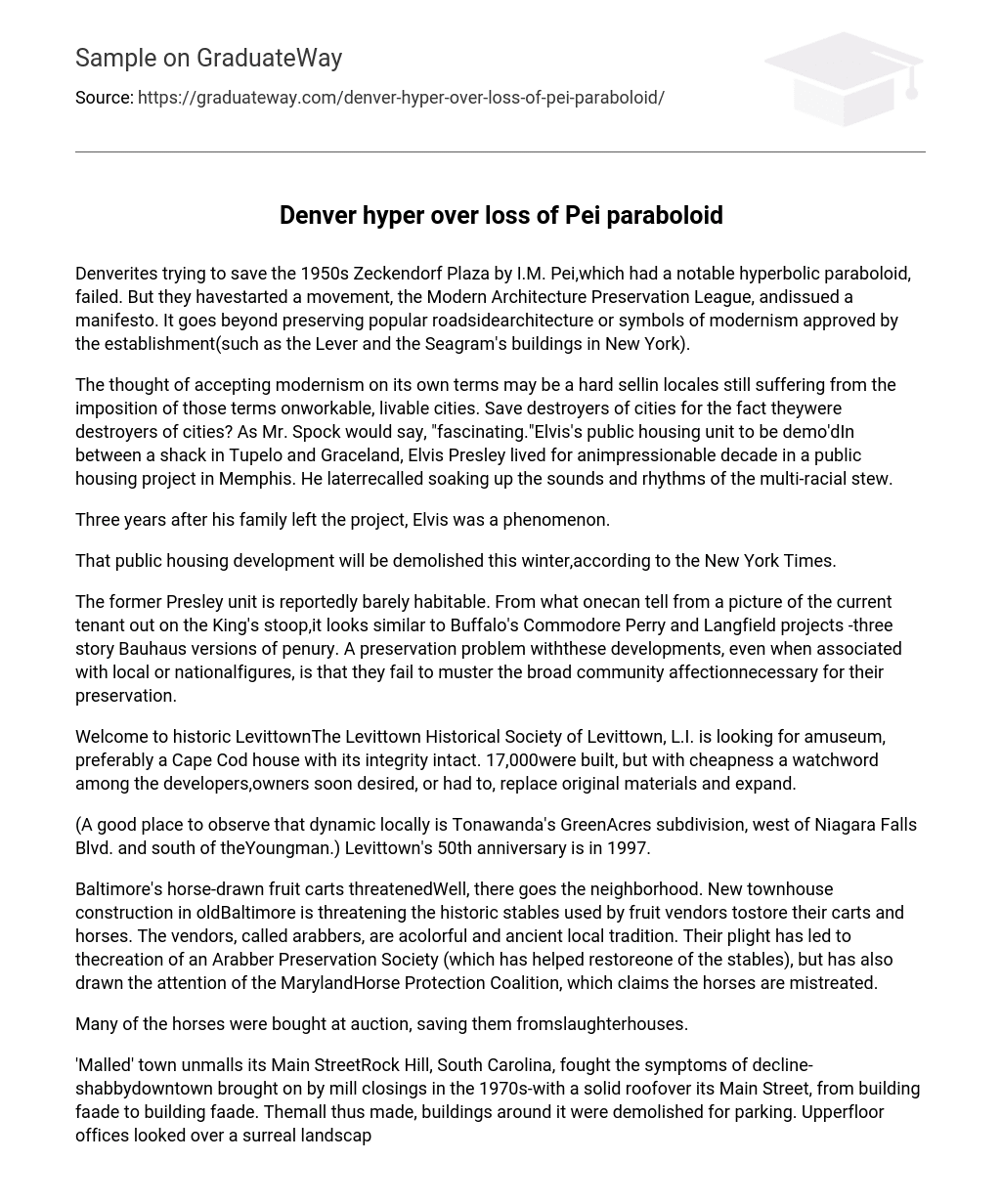Denverites trying to save the 1950s Zeckendorf Plaza by I.M. Pei,which had a notable hyperbolic paraboloid, failed. But they havestarted a movement, the Modern Architecture Preservation League, andissued a manifesto. It goes beyond preserving popular roadsidearchitecture or symbols of modernism approved by the establishment(such as the Lever and the Seagram’s buildings in New York).
The thought of accepting modernism on its own terms may be a hard sellin locales still suffering from the imposition of those terms onworkable, livable cities. Save destroyers of cities for the fact theywere destroyers of cities? As Mr. Spock would say, “fascinating.”Elvis’s public housing unit to be demo’dIn between a shack in Tupelo and Graceland, Elvis Presley lived for animpressionable decade in a public housing project in Memphis. He laterrecalled soaking up the sounds and rhythms of the multi-racial stew.
Three years after his family left the project, Elvis was a phenomenon.
That public housing development will be demolished this winter,according to the New York Times.
The former Presley unit is reportedly barely habitable. From what onecan tell from a picture of the current tenant out on the King’s stoop,it looks similar to Buffalo’s Commodore Perry and Langfield projects -three story Bauhaus versions of penury. A preservation problem withthese developments, even when associated with local or nationalfigures, is that they fail to muster the broad community affectionnecessary for their preservation.
Welcome to historic LevittownThe Levittown Historical Society of Levittown, L.I. is looking for amuseum, preferably a Cape Cod house with its integrity intact. 17,000were built, but with cheapness a watchword among the developers,owners soon desired, or had to, replace original materials and expand.
(A good place to observe that dynamic locally is Tonawanda’s GreenAcres subdivision, west of Niagara Falls Blvd. and south of theYoungman.) Levittown’s 50th anniversary is in 1997.
Baltimore’s horse-drawn fruit carts threatenedWell, there goes the neighborhood. New townhouse construction in oldBaltimore is threatening the historic stables used by fruit vendors tostore their carts and horses. The vendors, called arabbers, are acolorful and ancient local tradition. Their plight has led to thecreation of an Arabber Preservation Society (which has helped restoreone of the stables), but has also drawn the attention of the MarylandHorse Protection Coalition, which claims the horses are mistreated.
Many of the horses were bought at auction, saving them fromslaughterhouses.
‘Malled’ town unmalls its Main StreetRock Hill, South Carolina, fought the symptoms of decline-shabbydowntown brought on by mill closings in the 1970s-with a solid roofover its Main Street, from building faade to building faade. Themall thus made, buildings around it were demolished for parking. Upperfloor offices looked over a surreal landscape of roofing andutilities. Soon it was evident that a mistake was made. Years of studyconfirmed what everyone knew – the roof had to go.
“The only way to revitalize downtown was to return it to a villageatmosphere,” said Stephen Turner, the director of a private/publicdevelopment corporation. It has proved to be an expensive lesson – 20years and untold millions of dollars tossed to the winds – but atleast Rock Hill didn’t toss all its buildings to the wind. Restorationto pre-1970s conditions is underway.
The URL’s of these arehttp://bfn.org/preservationworks/bpr/December95/mall.html and that’s all! (





